Background
Video games were born in the early 50s. The first publicly known video game is Pong, which was released by 1972. This probably makes video games as the youngest media. Since then it broke user consumption records of any other media, such as: books and films [1]. Its success and the unique experience it offers has brought many myths around it.
The people who really understand games are the gamers. When they grew up and became academic scholars, they turn to research the influence of games on various aspects of our life. Game research is becoming a serious field of study, and this article brings results from not a few sources.
I hope you could learn to see games in a different light after reading these proof. Games can be a very effective tool, if you only use it right. It is better if we learn how to use it instead of trying to push it away.
Myth 1: Video Games Mainly Target Young Boys
Average Gamer’s Age
Video games are thought to be aimed mainly at young boys at the age group of 3 to 16 years old. Where actually the average player age is around 35 years old [1]. This shift happened mostly because the people who played video games when they were “born” in the 1970’-1980’, are now older. These players can now afford to make purchases for themselves or for their children. Apparently the average years that gamers are playing for is 13.

Age diversity among gamer population
Average Gamer’s Gender
Another interesting variable is the average gamer’s gender. The myth considers male being the lead target audience, whereas nowadays audience is almost 50-50. The average female gamer’s age is 43 and the average male gamer’s is 35 [1].

Gender diversity among gamer population
Games are truly diverse in the content and gameplay they offer, and it addresses all audiences. Take a look at these examples and you should find a few that you are either playing yourself or you know someone close that is.

From top-left: MineCraft, AngryBirds, CandyCrush, ClashOfClans, PokemonGo, ClashRoyale, Solitaire, Sudoku, MineSweeper
Sources
[1] Entertainment Sports Association (2015). Sales, Demographic and Usage Data: Facts about the Computer and Video Game Industry.
Myth 2: Video Games Socially Isolate The Gamer
Media separates us, causing us to be socially isolated with our device in our private virtual world. When we look at the two pictures below, most of us consider the card game as a socially connecting activity and the video game as a socially isolating one. Especially because of the direction of the faces and its expression.
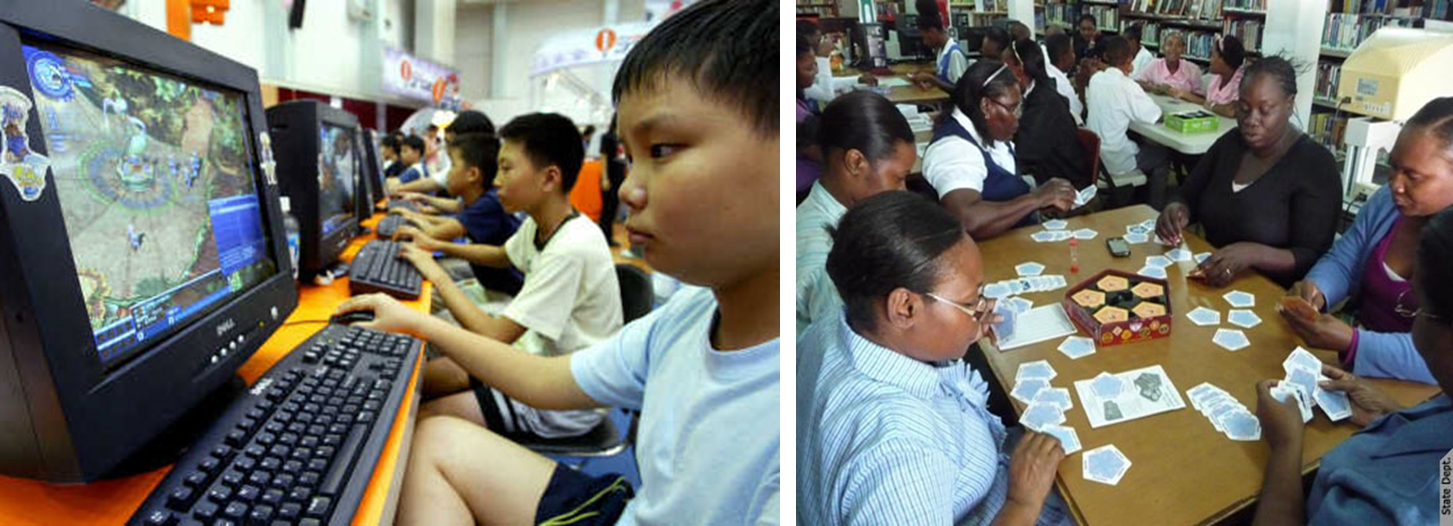
We see video games as isolating where card games are socially connecting
Social Pressure and the Rise of Multiplayer
Where, in fact, the social aspect is a very strong motivational power in nowadays gaming. At its beginning, the video game market was focused on players playing locally, on the same machine. But when internet was invented, games took an interesting turn and online multi-player gaming was born.
Nowadays, playing with a friend or family is significantly more popular compared to single player play. More than 50% of gamers claim that games are a mean to keep in contact with friends and family. About a third of the gamers play because of their friends, and are driven to play because of social pressure [1].
Massively multiplayer online games (MMO) are a unique genre of games that manages to keep players engaged for many years on a daily basis. World of Warcraft or League of Legends, as two of the leading game titles in that genre, have each around 10 million players playing the game each month. The players play for a few years in a row, average from 6-15 years!
The thing that makes MMOs really different, is the social interaction between the players. They talk, strategize, battle, fail, learn from mistakes, experience guilt and other emotions. And they do all this together. Talmadge investigated the game Counter Strike, a famous first-person shooter, and found that the game faces the player with real social dilemmas in front of real people [17].
Famous MineCraft is another example of an MMO video game. Kid gamers play this open world, harvest for resources, build castles with it, and defend from alien creatures at night fall. They do all that with their friends.
Remember that sturdy familiar gaze into the screen in the picture above? It probably originates from concentration, rather than from sadness.
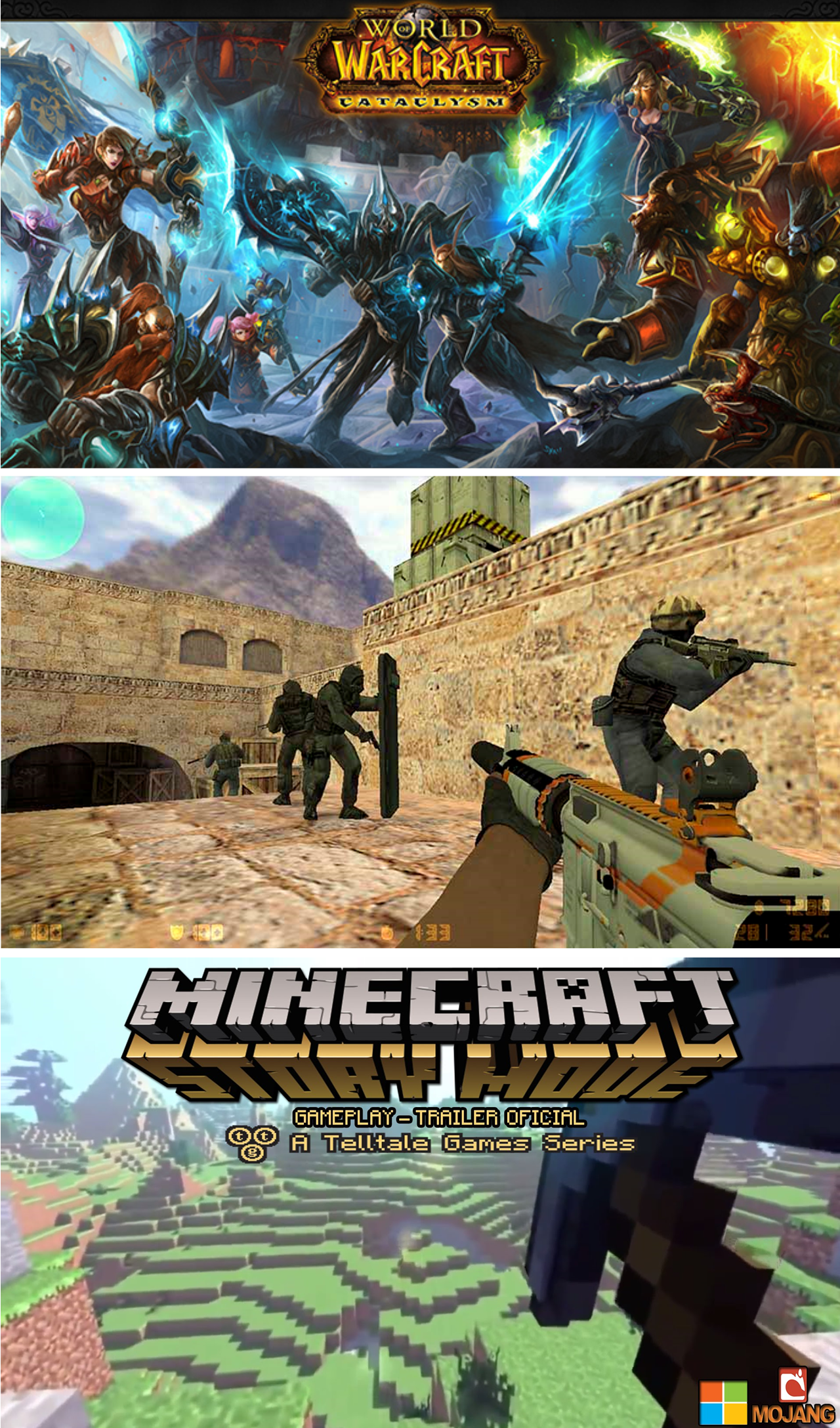
From top: World of Warcraft, Counter Strike, MineCraft
Game is Situated in a Social Discussion
Kurt Squire, Constance Steinkuehler and Sasha Barab are researchers with a different approach. They research the social influence of playing a game, not by looking at the game itself, but at the time between play sessions [2].
Squire claims that “video game playing is situated in social and cultural spheres, that are perhaps more important than the game itself” [3, 5]. When players sit outside the game, they are still thinking and talking about the game: strategizing, considering moves. Squire teaches game development but focuses the students to consider how to use this media to start a social change or movement.
Steinkuehler opened a gamers club for those who drop out of school. She said the majority of players join because of the games, but stay because of the social bond [4].
Squire urges educators to think thoroughly before integrating games into the class. “It is more than bring the game into school, it is actually fundamentally rethink education”, meaning don’t just introduce a new media into the class, consider how you are going to create a new social and educational movement around it.

Constance Steinkuehler. Taken from kids4play
Sources
[2] Dikkers, S., Squire, K., Steinkuehler, C. & Zimmerman, E. (Eds.) (2010). Real-time research: An experiment in the design of scholarship. Pittsburgh PA: ETC Press.
[3] Squire K. (2002). Studying the Impact of Gaming. In international journal of computer game research 2 (1).
[4] Connected Learning Alliance [Video file] (April 20th, 2011). Online Games and Interest-Driven Learning are Transformative for Today’s Young Learners.
[5] Yee, N. (2001). The Norathian Scrolls.
Myth 3: Video Games Make Gamers a Couch Potatoes
Games are considered to be played with a remote controlled sitting on the couch near the TV screen. They are said to make us numb, static, unresponsive and still.

“Myth: Gamers are Couch Potatoes”
Motion Tracking Games
The truth is that there are many games that actually have their gameplay based on player’s movement. Motion tracking games, like Microsoft Kinect or Nintendo Wii, track the player’s position and gestures using a special camera or wearable devices, and the games force the player to perform certain movements, such as boxing, sports or even dance moves.

Kinect game technology recognizes player’s body gestures
Location Based Games
Another type of such games are the location based games. Using the GPS tracking on our mobile devices, games know exactly where we are outdoor. They use that data in interesting ways to create an engaging game. GeoCaching is one of the first in the genre. In many ways it is an outdoor scavenger hunt, where people create riddles for other people.
Zombies, Run! is an app you start when you jog, and it creates a path for you according your progress. You would hear voices of zombies crying behind you when you need to speed up, and another person will direct you to a safe place.
But Pokemon GO is probably the most famous game of all in the genre, probably because of the publicity it got and the traffic jams it created. The virtual Pokemons are spread out in the world, and you need to get them all. You physically need to be near the creature in order to get it. Kids pushed their parents to go on a road trip just to get a Pokemon. But the age group was very diverse.

Omaha police organized a huge PokemonGo hunt during July 2016, to attract people to specific information points to learn about the police
Myth 4: Violent Video Games Create Violent People
This is probably the most sensitive issue of all. Nowadays most parents simply ban toys or games that have even some violent resemblance (Ferguson, 2010). There is no doubt that some video games present violent content, just like any other media: movies, books, etc. The difference is that video games offer personal interaction with content, whereas in other media the user is only the viewer of it.
The debate took off in 2005 when the American Psychological Association published a series of researches that reveal that not a few suicide shooters or mass slaughter terrorists, were also addicted gamers. Some even played right before they went to perform their criminal activity [6].
These publications have been the trigger for many gamers and researchers (myself included) to prove a contradictory truth. We knew that even though games present violent content, it cannot create violent people since we are not violent and nor does many other gamers we know.
In 2013, a petition was signed by 300 researchers, psychologists and game designers, to cancel the 2005 resolution by the APA [19].
Crime Rate is Reversely Correlated to Rise in Number of Gamers
The first proof that something was not right with these claims, was that even though the number of gamers is rising dramatically every passing year, the crime rate drops [14, 9]. This reverse correlation explains that there is no causal relationship between video game violence and crime.
Researchers didn’t stop there.
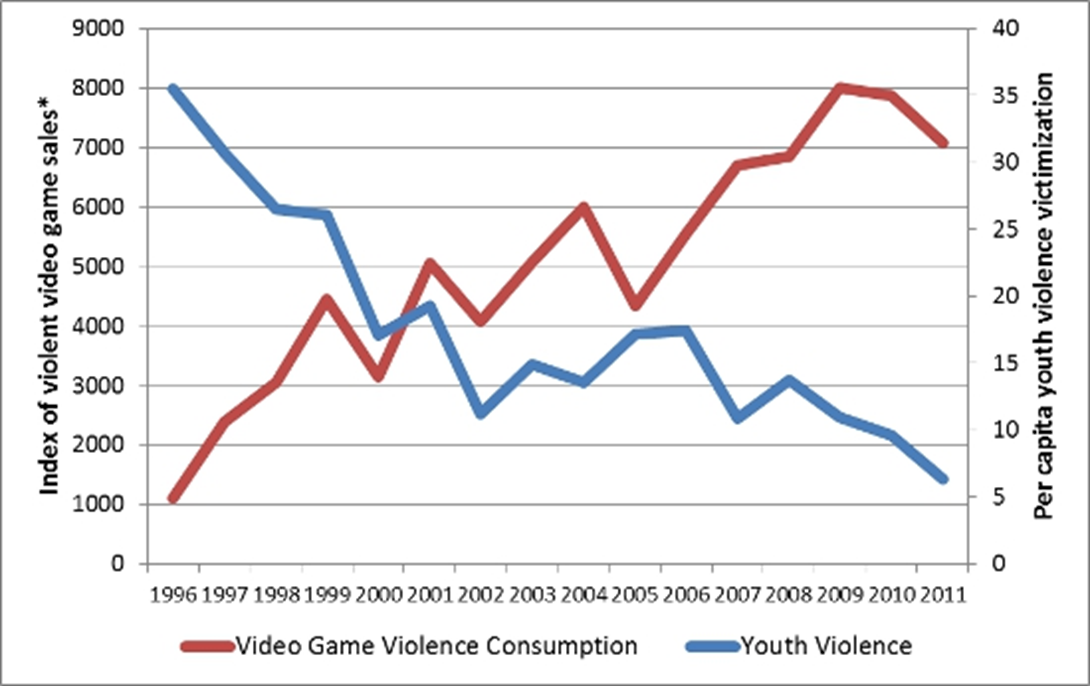
Reverse correlation between game consumption and youth violence
Violence and Aggression are Very Different
Patrick Markey investigated the famous shooter-gamer cases. He discovered that most of them had severe personality and social issues as well. Meaning, the video game itself cannot be identified as the sole cause [13].
It is only reasonable. Consider this, if you were to be forced to watch a very violent movie, would this make you kill somebody or perform an act of violence? Probably not. But if you were already hurt or with mental issues, this could have been a trigger, but nothing more than that.
Christopher Ferguson is probably the leading researcher in that field. He showed that when a gamer sees violence inside the game, aggressiveness is being triggered inside their brain, but it lasts for a very short while and disappears after a few seconds [9, 11]. Ferguson claims that violence originates from the human being and not from the media itself. Game creates short term aggressive response, but violence is on a completely different level [10].
Williams & Skoric investigated if aggression from video games will have influence after a long term play period. They let a group play a violent video game for several hours every day for a full month (average of 56 hours that month). Results show no difference in the way they socially interacted before and after that month. Actually, you can see that the control group showed more stress than the gamers… [16].
In 2015 the APA has released another resolution after a meta-study. They claimed that video game play is linked to rise in aggression, but it has not proven to increase lethal violence. They stated that aggression is temporary and certainly cannot be a sole cause of violent acts [7].

No long term influence after playing violent game
Aggression Arise from Failure Rather than from Violent Content
New research direction proved that aggression doesn’t arise from the violent content inside the game, but from the failure [15, 8]. When we fail a challenge we worked so hard for, we get disappointed. That feeling of failure creates an emotional response of aggression [18].
Most players don’t see the game as violent. The see it as challenging and they are focused in the task at hand. It is recommended to mediate the violent content for young players, and make sure they are not influenced by it.

Failure brings aggression, not violent content
Sources
[6] American Psychological Association. (2005). Resolution on violence in video games and interactive media.
[7] American Psychological Association, Task Force on Violent Media. (2015). Technical report on the review of the violent video game literature.
[8] Engerman J. A. (2016). Call of Duty For Adolescent Boys: An Ethnographic Phenomenology Of The Experiences Within A Gaming Culture. Dissertation.
[9] Ferguson C. J. (2010). Blazing Angels or Resident Evil? Can Violent Video Games Be a Force for Good?. In Review of General Psychology, 14 (2), pp. 68 – 81.
[10] Ferguson, C. J. (2015). Does Movie or Video Game Violence Predict Societal Violence? It Depends on What You Look at and When. In Journal of Communication, 65 (1), pp. 193–212.
[11] Ferguson, C. J., Olson, C. K., Kutner, L. A., & Warner, D. E. (2014). Violent video games, catharsis seeking, bullying, and delinquency: A multivariate analysis of effects. In Crime & Delinquency, 60, pp. 764–784.
[12] Kierkegaard P. (2008). Video games and aggression. In International Journal of Liability and Scientific Enquiry (IJLSE), 1 (4).
[13] Markey, P. M. & Markey, C. N. (2012). Vulnerability to Violent Video Games: A Review and Integration of Personality Research. In Review of General Psychology 14 (2), pp. 82–91.
[14] Markey, P. M. (in press). Video games and mental health. Invited chapter in H. Friedman (Ed.), Encyclopedia of Mental Health. Elsevier Ltd., Oxford, UK.
[15] Przybylski, A. K., Deci, E. L., Rigby, C. S., and Ryan, R. M. (2014). Competence-impeding electronic games and players’ aggressive feelings, thoughts, and behaviors. In Journal of Personality and Social Psychology, 106 (3), pp. 441-457.
[16] Williams D. & Skoric M. (2005). Internet Fantasy Violence: a Test of Aggression in an Online Game. In Communication Monographs (72) 2, pp. 217–233.
[17] Wright T., Boria E. & Breidenbach P. (2002). Creative Player Actions in FPS On-Line Video Games: Playing Counter-Strike. In Game Studies: The International Journal of Computer Game Research, 2 (2).
[18] Wright T. (2006). Killing Zombies, Terrorists, and Aliens: Video gaming and the pleasures and anxieties of symbolic violence. In Midwest Sociological Society. Omaha.
[19] Yee, N. (Mar 11th, 2014). How The Media Consistently Gets Games Wrong.
Myth 5: Video Gameplay Doesn’t Teach You Much
Most kids probably hear their mother shouts that they be better doing homework and not playing a video game. That happens because we do not see games as a teaching tool.
Well, that is one of the easiest myths to break actually. During one of my talks about this aspect, I showed the first slide presenting this myth, and a 12 years old kid stands up in his chair shouting “oh, now that’s really bullshit”. Everyone was laughing and I asked him to explain what the last thing he learned from games was.
Losing Can Motivate
Already in 2003, Kurt Squire managed to show how playing a game can be effective to learning [27]. He took school dropouts and challenged them to play Civilizations III, a video game that resembles more of a simulation than a battleground. First, he made sure they are motivated to play. He then challenged them even more by creating unbalanced situations and starting points. They were quoted saying things like: “I discovered that in order to win the game I needed to know more about geography” [26]. The fact that they even decided to keep trying to win after one or two failures is a wonder, since they have had not an easy life.
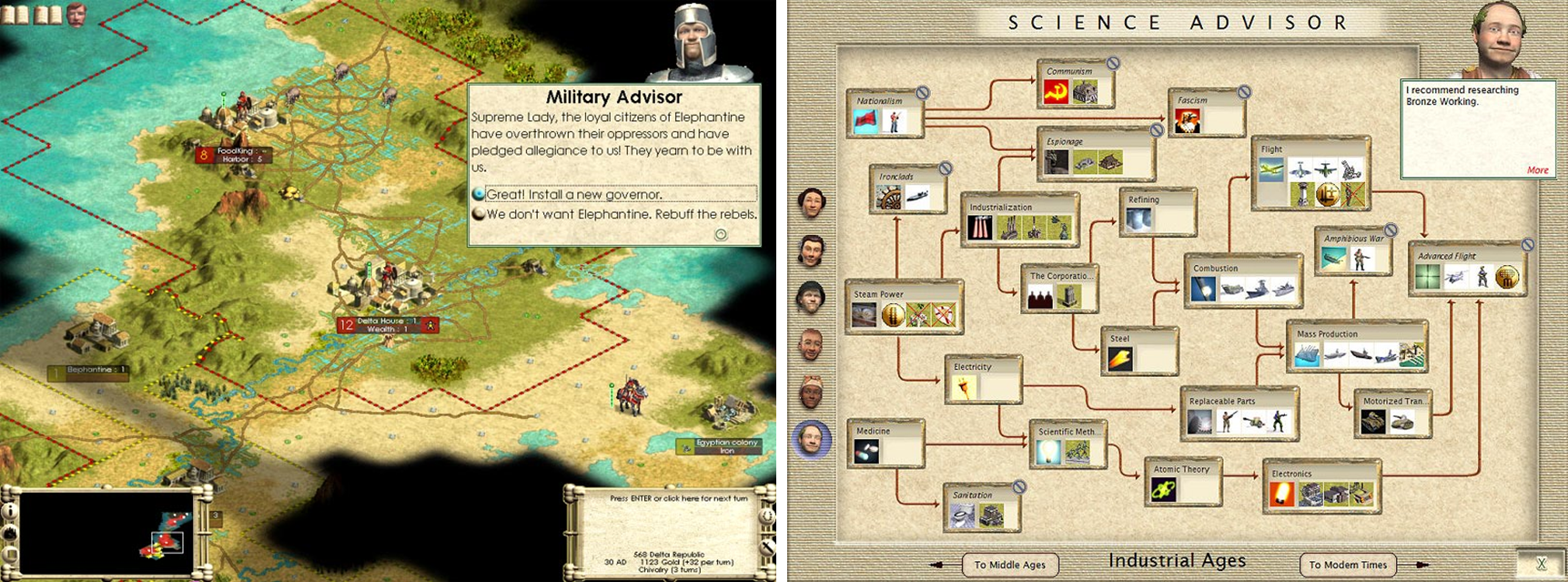
“Losing one time after another made me realize I need to learn more geography to win this game” Civilization III
The game SimCity is another great example to the amount of the responsibility the player has on the results. They play a mayor building a new town from scratch, deciding on anything. They get advisers, but they often contradict each other (build more green tech vs save money vs invest in education programs vs invest in industry). They need to design neighborhoods, roads, entertainment, industry, education. They even set the tax rate. This was a great intro to the world of running a city with its various systems.
Player can easily replay the game and try different approaches. All depends on player’s decisions. This is not a fast game, and it can be paused at any time. Players get time to make decisions. If they fail, they know exactly what went wrong. They know they failed, and they are ok with it. Most players see the point in trying again, and do not look at this as a personal failure.

SimCity: designing your town
Life Skills for the 21st Century
“Many video games require players to master skills in demand by today’s employers” [25]. This was one the many findings of a summit of 80 researchers, scientists and US government officials, with the goal to investigate the meaning of video games to education. They said that even though testing programs fail to assess skills like: performance under pressure, self-learning or complex analysis, video games certainly assist in its development.
In 2002 the US Army published a video game called America’s Army. The proclaimed goal was to draw more recruits to join the army and to better train the special units. The game is a first person shooter, and it has many training programs inside: tactics, weaponry, etc. The player starts from basic training and learns that team work is very important. A Rambo is not an acceptable behavior. The player learns to respect fellow man and the opponent. The Army values have been integrated into the gameplay, and players get that too. But above all, the game is used as a sorting tool for recruiters. If you get two candidates that one is level 5 in the game and the other is level 20 (assuming both played the same time), you would definitely hire the second one. The game collects a lot of statistics about the player in all the aspects of their choices [24, 22].
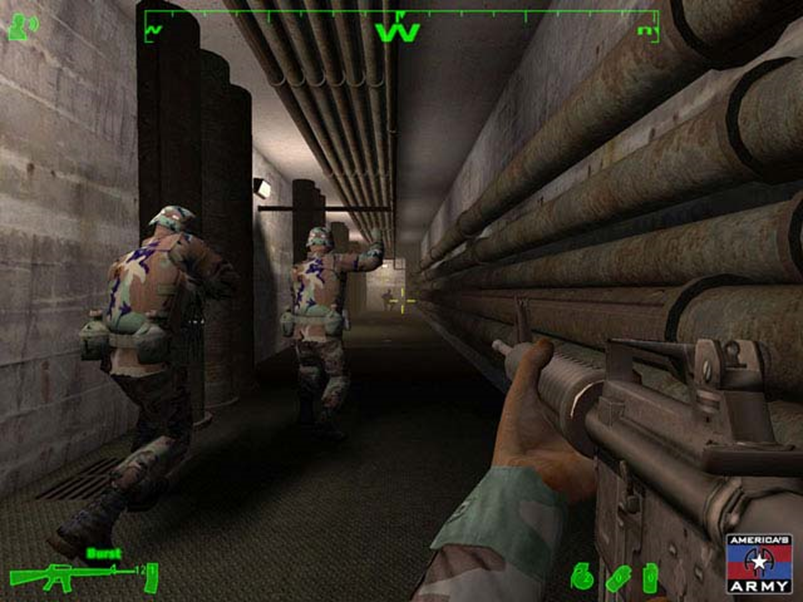
Americas Army: video game to help hire new recruits
Job simulator
The realistic nature of simulations paved a path to create job simulators of many types. One of the more serious ones I saw is the Dentist Trainer by Breakaway. But even though it is highly accurate experience and a fantastic tool to teach dentists to perform an implant, it is not a game.

Virtual Implant Trainer: Training to be a dentist
But Diner Dash is a video game that is a lot more fun to play. It is a great tool to teach memorization, multi-tasking, planning a head, speed and accuracy and more. Player runs a restaurant, take orders, sit the guests, make their food, serve and do the dishes. They collect money to purchase enhancements to increase revenue or new ingredients to add new dishes.
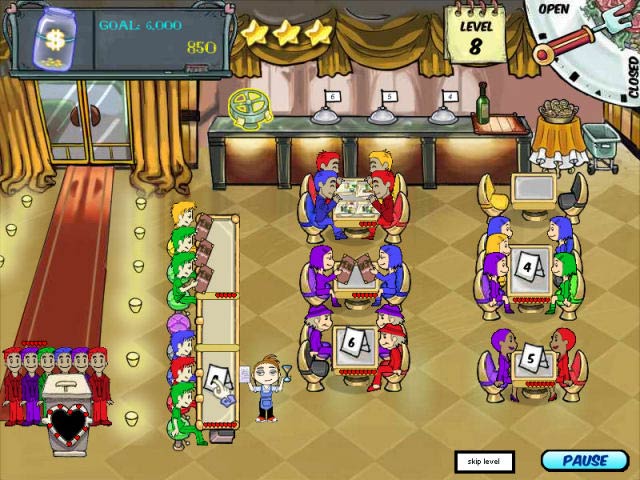
Diner Dash: Running a resuarant
Learning New Subject Matter
One of the first things any veteran gamer knows better than many others, is speaking and reading English [25]. Steinkuehler investigated the content gamers read in order to learn about the game itself. She saw that it’s in an academic quality. Her research proved that teenage gamers are able to read that content with comprehension, whereas they fail reading content at their grade level at school [28]. She found that when kids choose their own text they were reading 4-8 grades above their level.
Gee was among the first to discover specific relationship between the way games are built and the way we want learning to become [20]. Coming from game development, I have pinned nine similar principles between the game design building blocks and the instructional design [23]. Good games have these principles working in perfect balance, whereas instructional design and nowadays common teaching practices have a lot to improve.
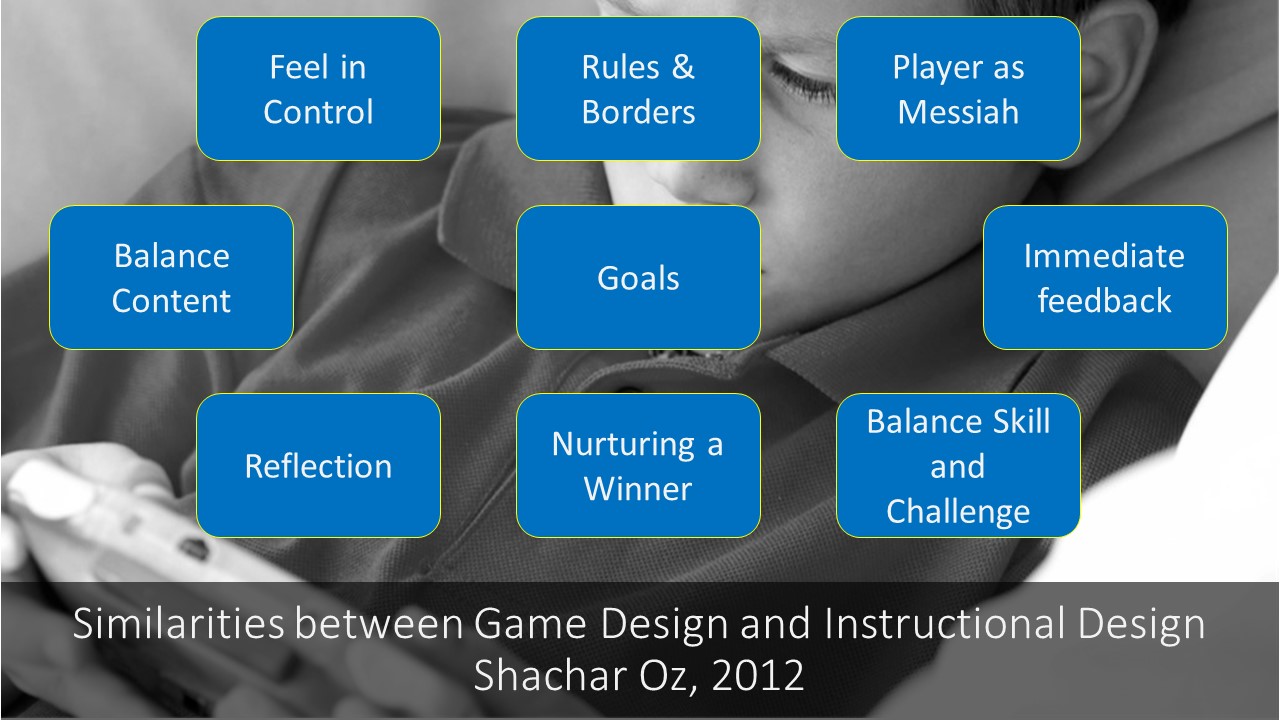
The nine principles of similarity between games design and instructional design [23]
Game-Based Learning
Making History II, is a video game about the Second World War. It aims to be a teaching tool in the classroom. Its scenarios are aimed for a 40 min lesson, and are easily set by the teacher [21].
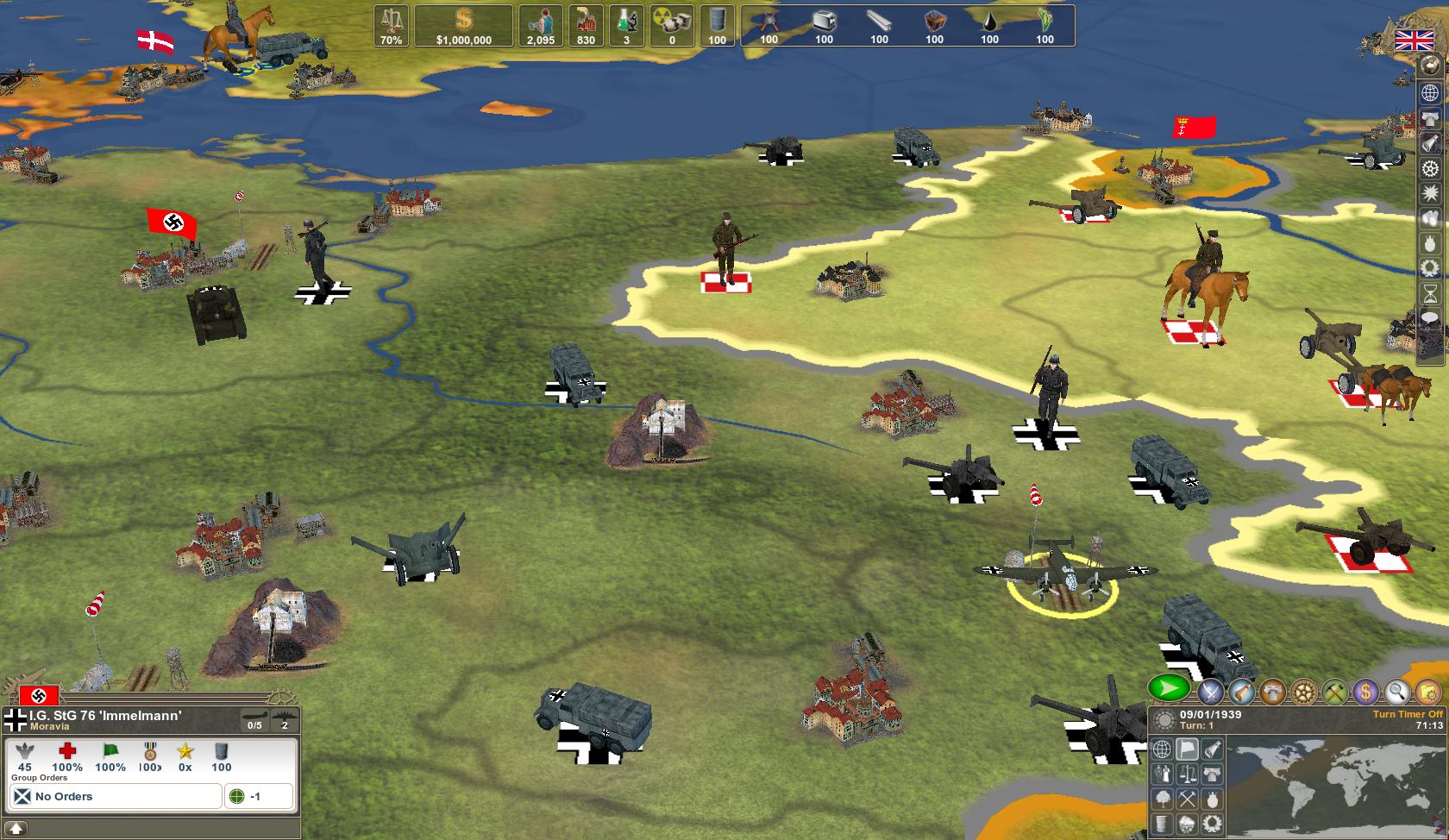
Making History II: video game for classroom settings
Fold-It is a video game that challenges players to compete in predicting the structure of protein molecules. A week after its release, the game results helped scientists to reach a breakthrough in the AIDS research [29, 30]. The research is said to be stuck in the past decade.

Fold-It helped solving a scientific problem of a decade in one week
Sources
[20] Gee J. P. (2003). What Video Games Have to Teach Us About Learning and Literacy. New York: Palgrave Macmillan.
[21] McDivitt D. (April 7th 2007) [video file]. Dave McDivitt & Making History at Oak Hill.
[22] Owen, V. E., Ramirez, D., Salmon, A. & Halverson, R. (April 2014). Capturing Learner Trajectories in Educational Games through ADAGE (Assessment Data Aggregator for Game Environments): A Click-Stream Data Framework for Assessment of Learning in Play. Presented at the 2014 American Educational Research Association Annual Meeting, Philadelphia, PA.
[23] Oz, S. (2012). Similarities between Instructional Design and Game Design. In Yair Y, & Shmueli E. (Eds.), The World of Open Information: Teleprocessing Teaching in the Higher Education (pp. 79-80). Rehovot: Weizmann institute of science.
[24] Reagan, M. B. (July 23rd, 2008). US Military Recruits Children.
[25] Summit on Educational Games (2006). Harnessing the power of video games for learning. Federation of American Scientists.
[26] Squire K. (2005). Changing the Game: What Happens When Video Games Enter the Classroom? In Innovate 1 (6).
[27] Squire K. & Jenkins, H. (2004). Harnessing the power of games in education. In Insight (3)1, pp. 5-33.
[28] Steinkuehler, C. (2012). The mismeasure of boys: Reading and online videogames. In W. Kaminski & M. Lorber (Eds.), Proceedings of Game-based Learning: Clash of Realities Conference (pp. 33-50). Munich: Kopaed Publishers.
[29] Lamm, G. (2011). How online gamers helped UW researchers solve AIDS mystery.
[30] Cooper S., Khatib F., Treuille A., Barbero J., Lee J., Beenen M., Leaver-Fay A., Baker D., Popović Z. & Fold-It Players. Predicting protein structures with a multiplayer online game. In Nature (2010).
Discussion: So How Should We Face Games?
So video games are not really what we thought they are. Each game has its own audience, and overall video games address a wide range in the population. Almost any great video game is multiplayer or have some social elements integrated into the gameplay. Some games even have physical motion as a core mechanic in the game. Violent content in the game does not create violent people, even though it might seem a little exaggerated at times. And finally, video games can be a highly effective learning tool, if used correctly.
They key here is that we need to know how to select an appropriate game for our player (child / trainee / ourselves). There are tons of bad games out there, and we need to be able to choose. There are a few ways to do that, but I will not get into that here. The shortest recommendation I can give is first try for yourself, before you let your child play it. Or sit with them, while they play, and ask questions about it. Don’t blame them for something, ask why in order to learn. When you feel knowledgeable enough about the game, you can decide if it’s good enough or not.
After we choose a game, we should learn how to use it. Take Monopoly as an example. After you see that your kids enjoy the game, you decide to use it to teach basic math. Now you will create scenarios that will force the players to bang their heads in math problems in order to win the game (example: change the prices from 100$ to 87$ or 102.4$). Monopoly can teach also English, Economics and even Real-Estate. It really depends how you steer the boat. Same principles apply to video games as well.
Converse with the player about their game experiences. Each match is a big opportunity to learn something and improve. Players would love to share their wins, so let them brag. Then ask about their weak points as well, and how they plan to get better.
Cheryl Olson offers similar tips to parents regarding video game play, such as: supervised play, asking kids why they play certain games, playing video games with their children [31].
Let’s wrap up with this: if you watch a movie that had an unexpected scene with violence or sex, and your child asks about it, you would need to give them an answer. What if they don’t ask about it? Would you open a conversation yourself if you see their twisted face expression? Same rules apply to video games. You need to be aware of the player’s experience, in order to know if it hurts them or it stays just a challenging and fun game.

Play with your child is the best tip.
[31] Olson C. K. (2010). Children’s Motivations for Video Game Play in the Context of Normal Development. In Review of General Psychology, 14 (2), pp. 180–187.
Written by Liron Levi and Shachar Oz, 2017
Levi L. & Oz S. (2017). Myth Buster: Are Video Games Really That Bad?. Retrieved [date], from https://www.flux-experiences.com/videogame-myths.html